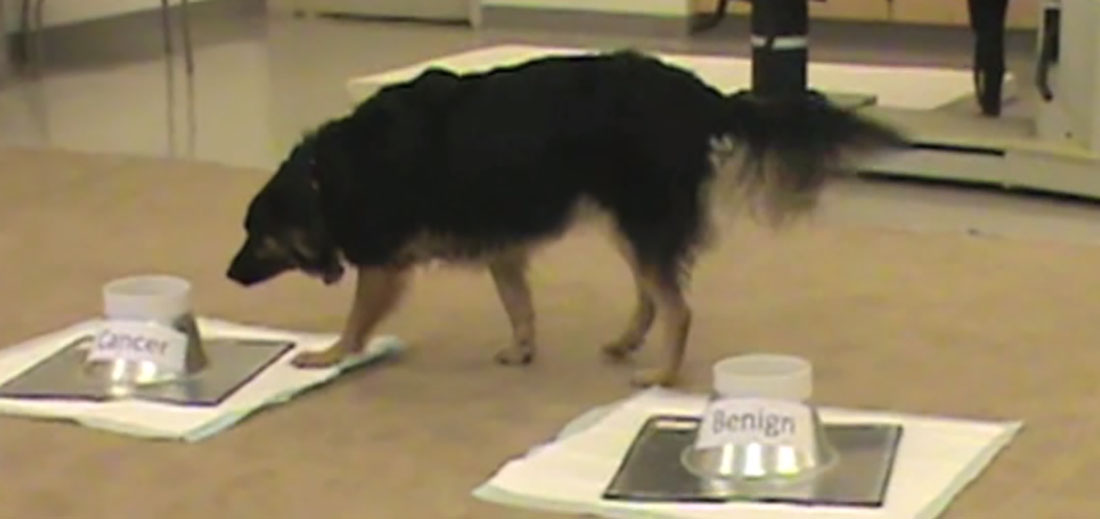By Angela Barnes
LITTLE ROCK, Ark. – A German Shepherd mix named Frankie and his two canine counterparts can detect thyroid cancer with 97-100 percent accuracy, according to researchers at the University of Arkansas for Medical Sciences (UAMS).
This life-saving role is a big change for Frankie who himself was rescued four years ago and has become the poster canine for the non-profit Frankie Foundation.
A team of doctors at the university is conducting a pilot study using Frankie, Sophie and Bella to detect thyroid cancer. They wanted to see if the dogs could assist physicians in detecting this type of cancer according to Dr. Donald Bodenner, UAMS thyroidologist and Dr. Arny Ferrando, research principal investigator.
“Since thyroid cancer is such a hard to diagnose cancer, we started down the road to see if the dogs could help in the diagnosis of thyroid cancers,” said Ferrando.
Testing the dogs: Reliability study
Using blood and urine samples from cancerous and non-cancerous patients, researchers found the animals showed a high degree of accuracy in detecting cancer. For example, Frankie gave the correct diagnosis with 30 out 34 urine samples. Bodenner and Ferrando realized the dog’s super sense of smell could detect cancer that is difficult to diagnose with current methods.
Nodules (abnormal growths) on the thyroid glands are one potential symptom of cancer. Dr. Andrew Hinson, postdoctoral fellow for thyroid and parathyroid surgery and research team member, said diagnosis can be difficult with conventional methods.
“Indeterminate nodules are really difficult to diagnose,” said Hinson. Doctors withdraw fluid from a patient using fine needle aspiration and send the fluid to a pathology lab for analysis. Pathologists use the phrase “indeterminate” to indicate that even after evaluating fluid from a thyroid nodule, they can’t tell whether the patient’s nodule is benign or malignant.
“Current methods have it where we can use molecular markers– a very expensive test. Often it comes back—at best—between 75 to 85 percent” in terms of accuracy, he added.
Using dogs, with their keen sense of smell, as clinical adjuncts to assist physicians in diagnosing thyroid cancer is less expensive, more accurate and reliable, said Hinson.
In the early stages, no visual signs or symptoms are associated with thyroid cancer.

This preliminary research is the first of its kind, according to researchers. The pilot phase of the study has been under way for two years, using Frankie, Sophie and Bella.
All the dogs were rescued by members of the research team. Frankie, for instance, was abandoned, emaciated, and heartworm- infested and was rescued by Dr. Ferrando. Now the dogs are using their natural powerful sense of smell to help their human partners.
To put the dog’s astute sense of smell into perspective, they have an exponentially higher number of smell receptors than humans. Depending on the breed, they average about 220 million to a human’s 5 million receptors, enabling them to detect trace odors imperceptible to people.
Scent-training process
Researchers trained the dogs to get them to differentiate between hot (cancer) or cold (benign) samples. Stefani Waggoner, UAMS lead dog trainer and former Marine trainer for bomb sniffing dogs said the dogs have to be imprinted or trained on the different types samples.
“During the training process we have to teach them what to do,” said Waggoner. We teach them the game mindset and then we imprint them on a volatile cancerous nodule.”
The dogs learn to use their own natural responses when surveying samples. For example, Waggoner would present Frankie with a hot (cancer) sample and then a cold (benign) sample. If the sample was hot, Frankie would sit down. If the sample was cold, he would turn his head away.
Patient samples
The samples used in the training sessions are from patients in Bodenner’s thyroid clinic. These patients have given written consent to participate in the study. The nodules for some patients providing samples are benign (noncancerous). Patients with cancer may provide samples before and after a thyroid is removed.
In addition, after one of the dogs began signaling at a wastebasket, the team quite unexpectedly made an amazing discovery: dogs could make a hot detection simply from a neck wipe. A wipe or Kleenex used to remove sweat from the neck and discarded triggered the dog’s detection response. These samples have now been incorporated in the canine training and study.
Currently, the research is not used to manage a patient’s care or to replace conventional diagnostics.
“Based on our results thus far, our research is promising as an adjunct to current practices and it is not intended to be the sole way to detect thyroid cancer,” said Hinson.
If successful, the canine research could be expanded into detection of other kinds of cancer with more dogs.
For more information about training dogs to detect human cancers or to make a donation, you can visit www.frankiefoundation.org
Travel and reporting for this story was generously supported by the Alumnae of Northwestern University.

